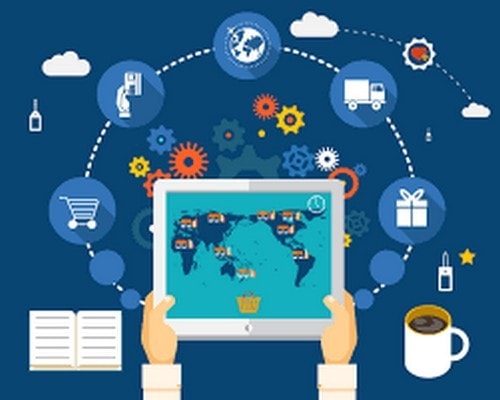Table of Contents
Suppy Chain Definition
A supply chain denotes a system in a business that involves organization, information, people, activities and resources that are used to move a product or a service from the supplier to customer. The range of activities involves the conversion of raw materials and the components to a complete and finished product in a form that can be delivered to the customer.
It is a network that exists between a company and its providers. It produces and distributes a specific product to the company. Supply chain ensures that the steps taken by the company help to reach the product or service to the customers.
Supply Chain Management (SCM) refers to the wide range of activities that are required to control, plan and execute the flow of the product, starting from obtaining the raw materials and then producing it through distribution to the final customer which is performed in an efficient and cost-effective way.
Consider an example of a retail store supply chain. The retail store selects the manufacturers, store them in a warehouse. They pack the products and then display the products in the retail shop.
Consider an e-commerce platform. An e-commerce platform is an example of a supply chain. An online store pertains to many products. It produces many products on a daily basis. They will make use of the warehouse to store the products that go to the destination and that are ready for delivery. The supply chain of e-commerce looks like the following:
As the name suggests, supply chain management handles all factors and phases of supply chain that involves goods and services. It also ensures the transit from manufacturer to supplier in a well-timed fashion. Supply chain management is important because the business exists in the global economy that is connected.
Elements of Supply chain management
Supply chain management combines supply and demand management. It refers to the planning and managing all activities that are involved in sourcing, procurement, logistics, and conversion. The main elements of supply chain management are:
1) Demand management
Demand management is a very important element in supply chain management activities. The company mainly focuses on meeting the needs of the customers more than the production process.
The company that is involved in the supply chain will make the partners aware of the existing customer’s needs thereby encouraging the business to increase the quality of the supply thereby adding value to the finished product. The business can improve the competition by having awareness of the customers.
2) Communication
Communicating effectively is yet another important element of supply chain management. Communication will help to improve its operations effectively which enables all members to share information regarding demand and operations. Communication will help to keep all members who are involved in the contribution of the supply chain, informed about the development.
This will enable them to adjust their operations that will meet the changing demand. By communicating effectively, all members will be able to respond quickly to the changing business opportunities, get new products to market on the fast track and then increase supply levels after a marketing campaign.
3) Integration
By integrating the supply chain process, the inventory costs will be reduced. Manufacturers will share the current information that is in high demand and then routes their product to warehouses. This will reduce the company’s costs drastically which enables the company to offer feasible pricing to the customers.
In order to achieve proper integration, companies must be able to develop a network that will enable all members to access and share information regarding supply and demand. The networks will be based on Internet so that communication among all members will become easier even though the internal networks are different.
4) Collaboration
Yet another element in supply chain, collaboration, which will help to strengthen the relation and communication between members, improve teamwork and then help each other to increase their businesses.
Many lead companies run programs and training that focus on the supply chain to improve the partners involved in supply chain market and the product knowledge. They will also start new product development programs with specialized partners who will contribute knowledge of business, materials, and components.
Role of the supply chain in distribution
Companies purchase products from the manufacturer as there is a requirement for routine inflow of products at regular intervals. When a manufacturer of the product is concerned, the factories will manufacture the product or goods and then send it in large quantities.
The manufacturers will not prefer to keep the finished products with them as they will target on selling the product and then go about for manufacturing the next set.
The manufacturers will also not prefer to sell the products to small users or to individual customers who will normally buy less as compared to the distributor. Selling to customers individually also involves in taking orders, shipping, creating invoice, payment collection etc. Hence in order to avoid such issues, organized channels called as individual distributors are set by the production facilities.
Most of the manufacturers will have five to ten production centers and warehouses. A distribution network can contain thousands of locations that will have inventory, staffed people, and product experts. These distribution centers will be close to customers that provide them with the products and services that the customers require.
Hence, when the individual customer places the order with the distributor, a distributor can examine the usage patterns and then recommend products that will last longer which cannot be done by a manufacturer who ships directly. When there is a requirement of service of a product, the manufacturer will cater to the requirement by sending a requirement which will be charged from the customer. When the customer deals with the local distributor, the distributor is well aware of the customer’s purchase and usage and will be able to guide the service required.
In short, buying directly from a manufacturer does not have a lower price or service for an individual customer. An organized supply chain has been created for this reason and it is considered as the most efficient and effective way to get a product from the manufacturer to the customer. By making use of a distributor as much as possible, customers can achieve the lowest cost solution and also meet their needs.
Conclusion
Efficient supply chain management is important to the success of a manufacturing unit. Supply chain management involves joint association between outsourcing partners, suppliers, and customers. It focuses on transforming the goods from raw materials to the finished products.
Liked this post? Check out the complete series on Distribution



